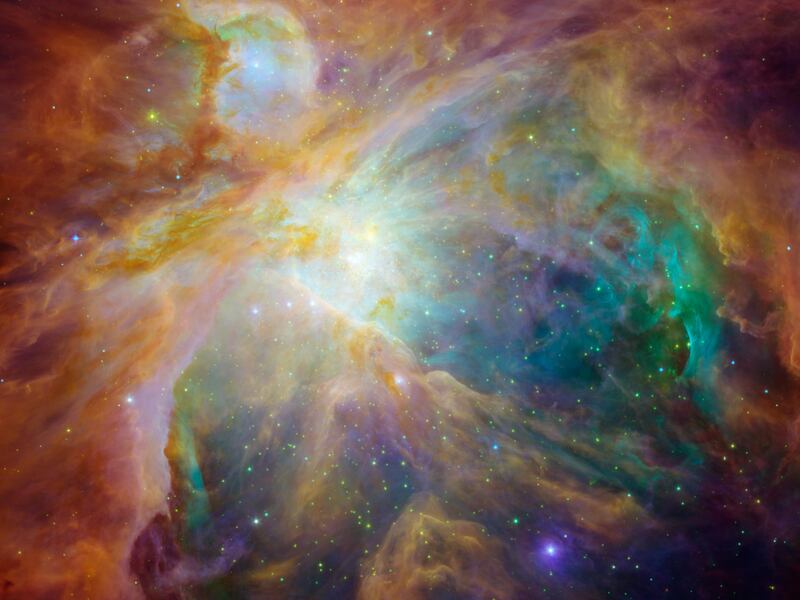Editor’s note: A version of this has been previously published on the author’s website.
Stories about Orion the hunter are varied and contradictory in ancient Greek and Roman mythology, probably because they were folktales rather than part of a formal religion. All agree that he was a giant, handsome and a great hunter. But reports of his life and death are diverge wildly, according to the Theoi Project, a compilation of classical mythology.
One tale is that he became a good friend of Artemis (Diana in Roman mythology), goddess of the hunt, but that her twin brother Apollo resented his chumminess with a mortal and tricked her while Orion was swimming. Pointing to a dot far out at sea, he challenged her to hit it. With her unerring aim and extraordinary strength, Artemis sent an arrow right through it — Orion’s head, on the surface as he swam. When the body washed up, she was devastated to find that it was her friend.
The first century A.D. writer who used the apparent pseudonym Hyginus (quoted by the Theoi Project online at www.theoi.com/Ther/Skorpios in a translation by Mary Grant, 1960) gives this account of Orion’s demise and transformation. It involves a long battle with a monstrous scorpion, which finally killed him, and the transformations of both into stellar constellations.
“Orion, since he used to hunt, and felt confident that he was most skilled of all in that pursuit, said even to Diana (Artemis) and Latona (Leto) that he was able to kill anything the earth produced. Tellus (Earth) (Gaia), angered at this, sent the Scorpion which is said to have killed him. Jove (Zeus) however, admiring the courage of both, put the Scorpion among the stars, as a lesson to men not to be too self-confident. Diana (Artemis), then, because of her affection for Orion, asked Jove to show to her request the same favour he had given of his own accord to Tellus (Gaia). And so the constellation was established in such a way that when Scorpion rises, Orion sets.”
To this day the two constellations are so arranged, Orion forever avoiding Scorpius.
New excavations of a small section of Pompeii, carried out to stabilize the ruins, uncovered surprising finds. Completion of the five-year project was announced by the Archaeological Park of Pompeii on Feb. 18 (see pompeiisites.org).
One striking discovery of the latest digs was a charcoal inscription carrying a date that translates as Oct. 17. It confirmed what some archaeologists had suspected for years, that the report of Vesuvius’ eruption on Aug. 24, A.D. 79, was mistaken. Either a famous letter by Pliny the Younger — an eyewitness who wrote 25 years after the disaster — was wrong about the date, or an error crept in during centuries of transcribing the letter by hand.
An Archaeological Park of Pompeii press release from Oct. 28, 2018, explains, “The inscription appears in a room of the house which was undergoing refurbishment, while the rest of the rooms had already been completed; works must therefore have been ongoing at the time of the eruption. Furthermore, since it was done in fragile and evanescent charcoal, which could not have been able to last long, it is highly probable that it can be dated to the October of A.D. 79, and more precisely to a week prior to the great catastrophe, which according to this hypothesis occurred on the 24th October.”

For those of an astronomical bent, another recent find also is wonderful. On April 9, the Archaeological Park of Pompeii released a video compiled from drone footage, covering the rescue excavations. “Here we now enter a house in front of the House with the Garden, on the other side of Vicolo dei Balconi, the house which we have called the ‘House of Orion,’ on account of two beautiful mosaics which are preserved in two of the rooms of the house,” states the video, in translation.
Later, it describes one of the mosaics:
“There is a cobra in the foreground, which symbolizes the Earth, from which emerges the scorpion that kills Orion. ... But the myth is an example of what the Greeks would call Katasterismos, that is it narrates the metamorphosis, the transformation into a constellation, in this case of the hero Orion, a Greek hero who was indeed transformed into the constellation which we can still see today.”
The mosaic, says the video’s narrator, “is the only one of its kind.” And the constellation, which blazes so brightly that its great Orion Nebula is visible to naked eyes in January and February, is to the Earth-bound observer the only one of its kind.
Joe Bauman, a former Deseret News science reporter, writes an astronomy blog at the-nightly-news.com and is an avid amateur astronomer. His email is joe@the-nightly-news.com.


